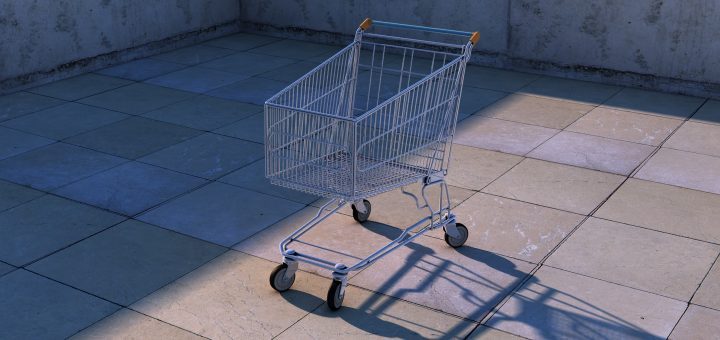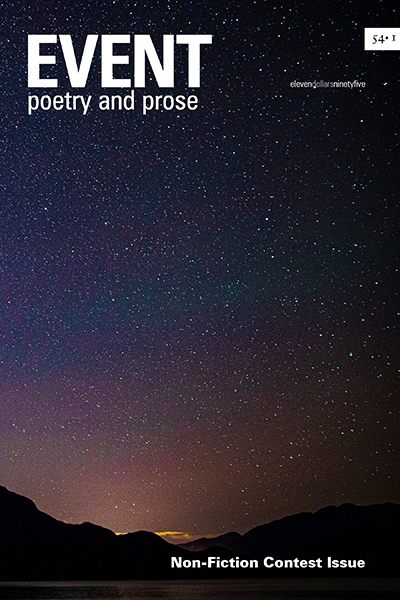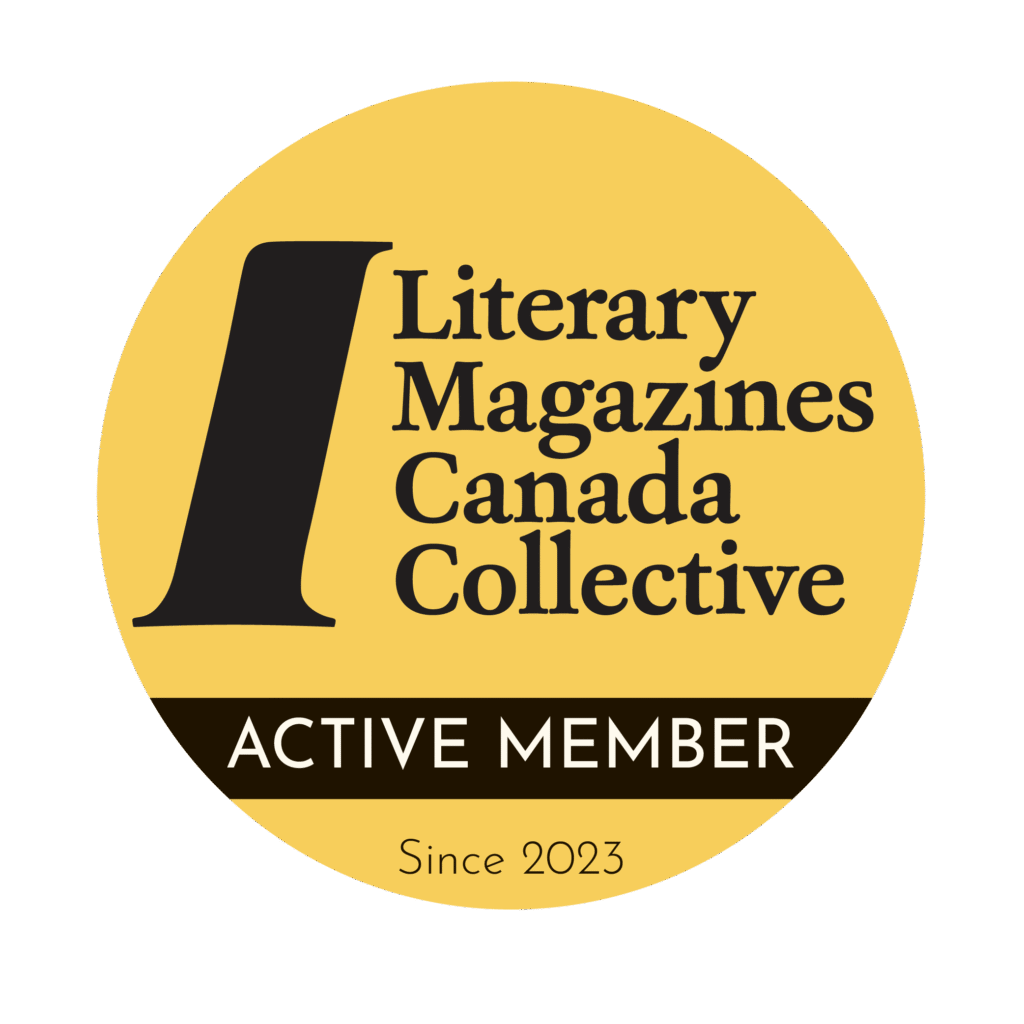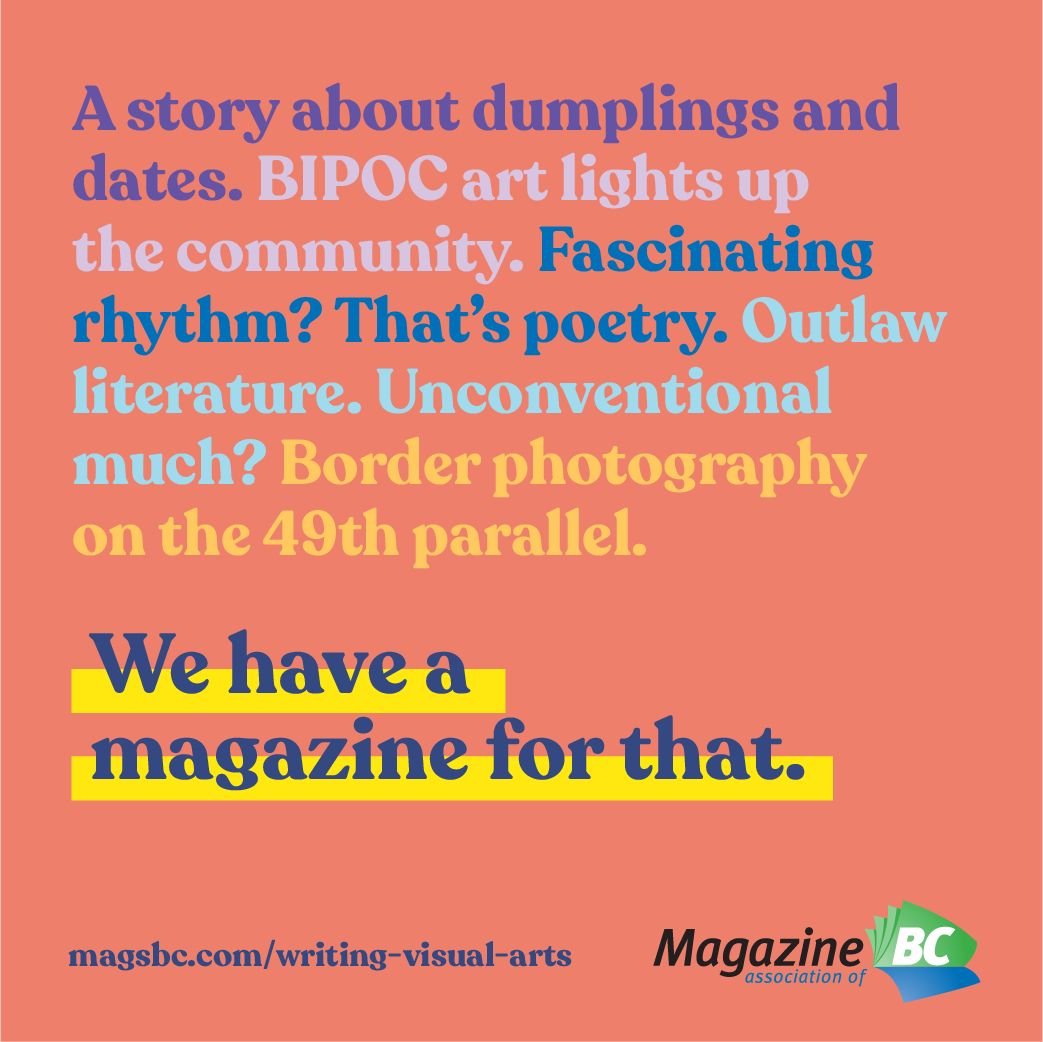Students Respond: Poems by Janette Fecteau
Poetry students at Douglas College were asked to respond to poems in EVENT, discussing observations on technique as well as what they learned as writers. Over the summer we’re posting a selection of their thoughts with the accompanying poems. The two poems below, by Janette Fecteau, first appeared in EVENT 45/2. The poems are followed by excerpts of responses by Amanda Proctor and Chlöe Rowat.
Shopping with My Mother
Mom took me shopping for a winter jacket, damp December, the morning bus
from Antigonish. The bus full of smokers; we arrived in the city at noon,
reeking of tobacco. By then I had a headache, so Mom gave me a tin of aspirin
from her purse. I pried the lid with no fingernails to speak of, and when it popped
open, the pills scattered all over the grimy tiles of the Halifax Sears bargain
basement. I wailed a child’s wail, while my mother scooped the pills and pitched
them into an empty ashtray of polished brass, the kind they used to call
a standish. After that, I lagged behind her in the jacket aisle, refusing offers
of nylon, flannel or rough wool. Ski jackets, doe skins, peacoats—she scrolled
through every last one on the rack. I made believe I was in that part of the store
by some accident, adult and alone, nothing to do with this grubbing woman.
A stranger tapped my shoulder then, a grey man who pressed our pills into my
hand. Put these away, he said. Some child might find them and think they are
candy. I pivoted mutely and beelined for my mother, blood buzzing in my ears,
hating the man’s impeccable nails, his overcoat, the unassailable logic of his
reproof. Despised my palm for reaching up, taking everything he gave. Years later
I still want to lurk behind my mother, cleave my blurry self to her, tell her softly
Mom, I like this one. The one with the blue collar. Under the sign that says
MARKED DOWN.
-Janette Fecteau
‘The first thing that drew me to this particular poem was the title. My immediate reaction was to say “Oh no,” because it instantly gave me an image of my own childhood experiences of shopping with my mother. It was something I loathed as a child, and honestly, I don’t think that fact has changed now that I’m an adult. The main reason is because shopping can be stressful, but also because I want to eat when I’m stressed because I’m a stress-eater and I usually get hungry about 15 minutes into the horrendous activity and want to leave. Even in those rare instances when my mother would have brought me along because we were actually shopping for something I needed (like a coat), this poem gives me a great sense of familiarity, humour and nostalgia.
Janette Fecteau is clever in choosing the form to shape this poem. By making a great wall of text, you can’t help but fall automatically into the childlike stream-of-consciousness. This prose-like form contains the experience of the speaker well. The style makes me think of someone who still remembers the event vividly, though there has been enough time for them to reflect upon it. The tone of voice, however, fascinates me. Although the language chosen is more mature than a child’s, the emotion behind it says otherwise. Phrases like “grubbing woman,” and “impeccable nails” make me feel as though there hasn’t been enough time to detach emotionally from the event that took place. It makes me wonder how old the speaker is, at present. My guess would be a teenager, who is reflecting on their past experiences in a Sears.
Another very distinct technique I see in this poem is alliteration. Examples like “damp December,” “bargain basement” and “popped… pills” stand out to me. Repetition of the consonant P is used quite often, jutting out at me, especially after reading it several times. This proves to be a strong choice, especially when we are given the voice of the grey man, already jarring due to it being the only part of the poem in italics. The first thing he says is “Put these away,” subsequently starting with the letter P, funny enough.
I also love the duality between ‘make believe’ and reality. The speaker first explains that they were in the store, “adult and alone,” but later when addressed by the grey man, he says to the speaker, “Some child might find them and think they are candy,” giving us the impression he’s speaking to another adult. Another great example of this is when the child leaves the man, saying “I pivoted mutely and beelined for my mother, blood buzzing in my ears.” Using the word ‘buzz’ is not only onomatopoeia, but also a great transition from a hyperbolic term like beeline to a real reaction, like feeling embarrassed and become red, while also continuing with the analogy of being a bee.
In the singular time the author uses repetition, what makes the line “I wailed a child’s wail,” so effective is that we can’t help but create the image of a child crying, and crying really hard. Rarely in everyday life do we hear adults refer to a cry as a wail, unless it’s something guttural, uncontrollable and somewhat involuntary; further instilling the idea that the speaker has an emotional response to dealing with the activity of shopping with their mother.
As a newer writer, I really take pride in this form of poetry. Stream-of-consciousness is a style that I seem to gravitate towards, and I also enjoy the idea of blurring the lines between reality and make believe, to help keep the reader engaged.’
-Chlöe Rowat
Boys Don’t Like to Be Chased
my grandmother told me, though I saw
counter-evidence. Like when Kath
let boys dunk her in the snowbank
in the ell behind the school. The way
she screeched, translucence in her eyes.
But when Richie’s friend made to pitch me in,
I shoved him right back with both hands.
Stood there stupidly and watched
Kath’s Lee jeans get wetter and wetter. Flecks
of snow caught in her hair. She chased Richie
across the parking lot, throwing fistfuls of powder.
And he liked it. Grandma,
wasn’t it supposed to go
the other way? Like when the Foleys made
a game of hunting me in the woods, down
paths we all knew, how I ran pell-mell in my sneakers,
the ecstatic terror, biggest boy at my heels. Surely
as things were meant to be. But I managed to get ahead,
duck unseen through a wall of spruce and enter
my secret field as they all shunted past. The field
where my grandfather’s father built his farmhouse,
one hundred years ago. Only grassed-in root cellar
to show for it now. I hid in that depression,
my eyes level with the seed heads of timothy,
a hare, a cricket, a snake.
-Janette Fecteau
‘The two images of the poem use evocative words, even though the language isn’t flowery. The line, “Like when Kath let boys dunk her in the snowbank in the ell behind school,” creates a vivid scene using specific language, like the name Kath, and the location of the snowbank. The line only describes a single action; however because of the specific nature of the language an entire scene can created by the reader. In the second stanza, “wall of spruce,” and “grassed-in root cellar,” fill in the setting. Similarly to the first stanza, by naming the type of tree, and by describing the cellar as a “root” cellar, the poet gives the reader highly specific images to latch on to, and from there the rest of the scenes fill themselves in. Though the language of the poem isn’t embellished, the poet’s use of specific language creates concrete images for the reader.
Each formatting choice in the poem adds to the meaning of the poem itself or serves a functional purpose. This poem stands out from others format-wise because the title is incorporated into the poem, joining to the line, “my grandmother told me,” and instantly throwing the reader into the first scene. This first line is the first hint that we get that the poem is addressed to the speaker’s grandmother, and it establishes a more conversational tone. I think this is a particularly effective technique to utilize when writing a poem that not everyone may personally identify with; to write it as though telling someone close to you about an experience, gives the reader a more open mind, as we feel closer to the speaker. In using the title as the first line of the poem, its conversational tone serves to enhance the reader’s experience if they have not dealt with the subject matter of the poem directly.
The change in alignment in the middle of the poem functions to bridge the gap between the two stanzas, but also illustrates how the form of a poem can match the content. The line “wasn’t it supposed to go,” is aligned to the right of the column, while the second half of the sentence, “the other way,” is aligned to the left. The alignment of the sentence is literally mirroring what the sentence is saying: by having a piece of the sentence that is out of place, the reader is taken aback, and wonders the same question the speaker is asking. However, this moment also adds to the greater meaning of the poem, indicating that even though boys aren’t supposed to like being chased there’s something off about that assumption, and the right alignment puts the reader on edge. The choice to align the middle part of the poem differently is normally done functions well to add and reinforce the deeper meaning of the poem.
In beginning to write poetry one of the things that has challenged me the most is finding a way to compress as much as possible, while still retaining a greater meaning and clarity of images. The techniques in this poem have given me more tools to utilize compression without losing meaning or clarity, and create poems that more people can relate to. One technique I hope to make use of in the future to imbue the images I attempt to create with deeper meaning is the use of words with double meanings. This poem has also demonstrated for me that to further compress things, using specific language can create vast images in reader’s heads, and evoke scenes in a single sentence. I have also learned that addressing the poem to a specific person helps to create a more conversational tone, and draw readers in to a subject that they may not otherwise be familiar with. Another element for writing I have drawn from this poem is how to incorporate format into the crafting of my poems. Even the way a poem is aligned can put the reader on edge, add to the mood of the poem, or add further meaning to the ideas without adding any extra words.’
-Amanda Proctor
—
Read more of Janette Fecteau’s poetry in EVENT 45/2.














